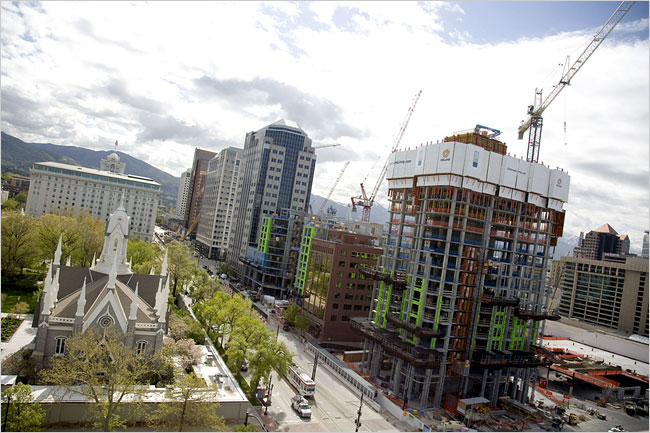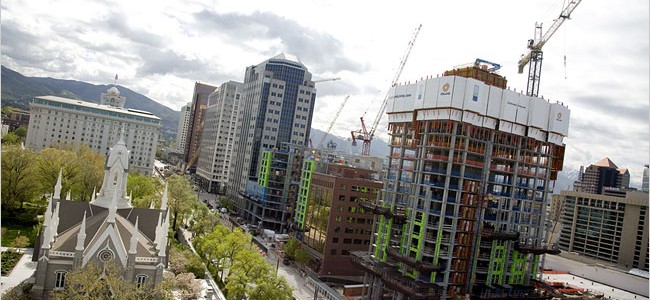 I’m sure the new City Creek Center is amazing. According to the Deseret News, thousands flocked to the new development this past conference weekend. The church reportedly invested $1.5 billion in the project.
I’m sure the new City Creek Center is amazing. According to the Deseret News, thousands flocked to the new development this past conference weekend. The church reportedly invested $1.5 billion in the project.
If I’m in Salt Lake, I’ll go see it. I’m sure it will be as grand as advertised. I’ll walk around for a while, mesmerized by the scale and luster of it, and then I’ll remember that the development-everything, including the fountains, the retractable roof, and the $20k Rolexes-is a physical manifestation of my religion, and the dissonance will start to eat away at the shine of it. I wonder how different things would be if we could fuel a bonfire with our collective vanity and let the heat forge it into something else-something else more worthy of our humanity and our spiritual aspirations.
I’m a business professor. I understand the mechanics of the situation. I know the church takes in more than it spends, and therefore has “reserves” it needs to invest. I understand that saving is a kind of thrift. I realize that there is an element of social responsibility in the decision to invest in a way that “revitalizes” the heart of a city.
But when I think of religion-true religion-I think of Doctors Without Borders, VillageReach , or The Small Enterprise Foundation (or hundreds of other similar organizations). I think of the hard work of those dedicated to alleviating the suffering of other human beings. When I see these kinds of efforts, it inspires me. It makes me want to do more. It makes me want to be a better person.
I don’t care where the money came from (and it’s silly to debate whether it was tithing money, or profits from invested tithing money, or profits from businesses started with tithing money, particularly in light of the new fine print on donation slips).
We seem convinced that God blesses the righteous with material wealth (Exhibit A: The “Pride” cycle in the BoM; Righteousness = Material Wealth = Pride, although we don’t worry too much about the last part of the cycle). It seems like we’ve turned things around, though. Somewhere along the way, we decided we needed material wealth so that our neighbors would see that God has blessed us (and then infer that we’re righteous). The church’s presiding bishop, H. David Burton, explained at the recent City Creek opening that it’s vital to create an atmosphere in Salt Lake City that people like and remember. He summed up his argument by stating, “Because Salt Lake City is the capital of Utah, it’s important that it is ‘dressed appropriately.'”
So that’s what this is about? By its own admission, the church allocated a total of $30.7 million in cash to non-Mormon charity work from 1984 to 1997, but investing 50 times that amount ($1.5 BILLION) in a high-end shopping mall is just part of “dressing appropriately”? It occurs to me that the vast majority of the time, energy and wealth members contribute to the church is directed internally-on building and maintaining our own gated community. Now, at least, our gated community has a nice club house. . . and our neighbors will see it, and I’m sure they’ll be impressed, like Bishop H. Burton suggested.
I wonder how far this kind of thinking extends. I suspect that the “need” to “dress appropriately” has something to do with this, and this, and this (and literally, with this)–and other trends in Utah that aren’t flattering.
This may have been a good business decision, at least in some respects (more on that next week), but that’s the problem. . . Good businesses decisions aren’t something religions should be proud of. I can’t help but think of this old Monty Python skit (or on a more serious note, this book).
On second thought, even if I’m in Salt Lake, I may not go (although I’ll be tempted to). If I have time to waste at City Creek Center, I have time to volunteer at a local soup kitchen or homeless shelter. . . and I’ll feel better afterwards.
[Here’s another great blog post on City Creek by Jana Riess]
[Last Post: 24 “We know that. . .”]

I agree, and made these shirts to illustrate the point. The shirt says:
What would Jesus Build?
a) A mall
b) Condos
c) Both (a) and (b)
d) None of the above
I will send $5 to Doctors Without Borders for each of these shirts purchased, up to $500. My brother will cover the next $500.
Oops- The URL for the shirts is http://392922.spreadshirt.com/
You can click on my name for link, too.
This is my question, was it a good business decision?
If you have lots of money does investing in a shopping mall
Make sense? I know nothing about business, all I
Know is you don’t see some of our well known billionares investing in malls, do you?
When would you guess the church will see a return on their investment?
Thanks for this post, Brent. I find it difficult that so many Mormons find the Church to be above reproach or criticism in this matter, while at the same time criticizing other churches for their extravagant cathedrals and monuments.
Yeah, that’s the rub, for me, too.
I think the church has always been busy building as much outsider and insider-pleasing spectacle as its means would allow. See Kirtland, Nauvoo, Salt Lake City, temples, … and the temple/administration complex in SLC is the heartbeat of this long-lived reality. Arguably this is all good business as the business of running a church goes … And god knows, this is an enviable business.
What I see here with the move to capture the retail/residential sector surrounding the temple spectacle is a move to further extend and buttress the age-old spectacle. And I get that some people are shocked by what appears to be an extravagant and immoral endorsement of consumption and others not so much. This is the nature of the “shock and awe” business model of god.
As long as the LDS church continues the natural progression of its founding design, and continues to expand its means, there will be only more such “shock and awe”.
Because, net-net-bottom-line …. Appeals to basic human morality are only the guilt-assuaging counterpoints to a vision of the world where gross injustice and vanity-seeking are done in the name of God.
I work a few blocks away from City Creek and I am of two minds about it.
Like most American downtown areas, Salt Lake’s downtown has been dying. Already Main St. today has twice as many business open than it did just 6 months ago. And not all of them are LDS-approved National Chains, some of them are funky and weird, bars even.
Unfortunately, many of the retailers in City Creek just moved their stores 3 blocks east, from the older Gateway Mall. That mall is ghost town now. Great stuff like Sam Weller’s bookstore and Vesuvio’s Cafe are gone. Many of the condos remain unsold, despite prices becoming somewhat more reality-based. The only stuff I can really afford to buy at City Creek is in the food court, but there are better, local restaurants and food carts way closer to where I work and live.
I guess I have come to the conclusion that City Creek really isn’t for Salt Lake City folk. It’s like the parlor that you invite guests into, but keep the kids out of. If the goal of City Creek is urban renewal, I don’t know if the LDS church is way ahead of the curve, or way behind.
It’s just a big ol’ mall, not the Lord’s Mall. It didn’t leave me with a burning in the bosom, just a vague sense of ennui.
I’m all for revitalizing downtown SL, and, in all honesty, the Church is the only entity large enough to the project on. No, I haven’t visited yet. Shopping is not my form of recreation.
QFT Matt: “This is the nature of the “shock and awe” business model of god.”
And I dig the historic connection to Temple building. What is City Creek but a temple to consumerism?
The Church is far more modern than we think.
It put hundres, if not thousands of people in Utah to work!! Something this economy needed.
Think of the families it fed. Feeding those families was a far greater blessing then you are giving it credit for.
Mrs Smith – I did not sacrifice 10% of my income so that we can build mall for people to max out their credit cards. I paid tithing so that the church can use it to build chapels etc and help those in need.
Putting people to work ….something the economy needs? Funny, a strip club in my town used the same rational that you used.